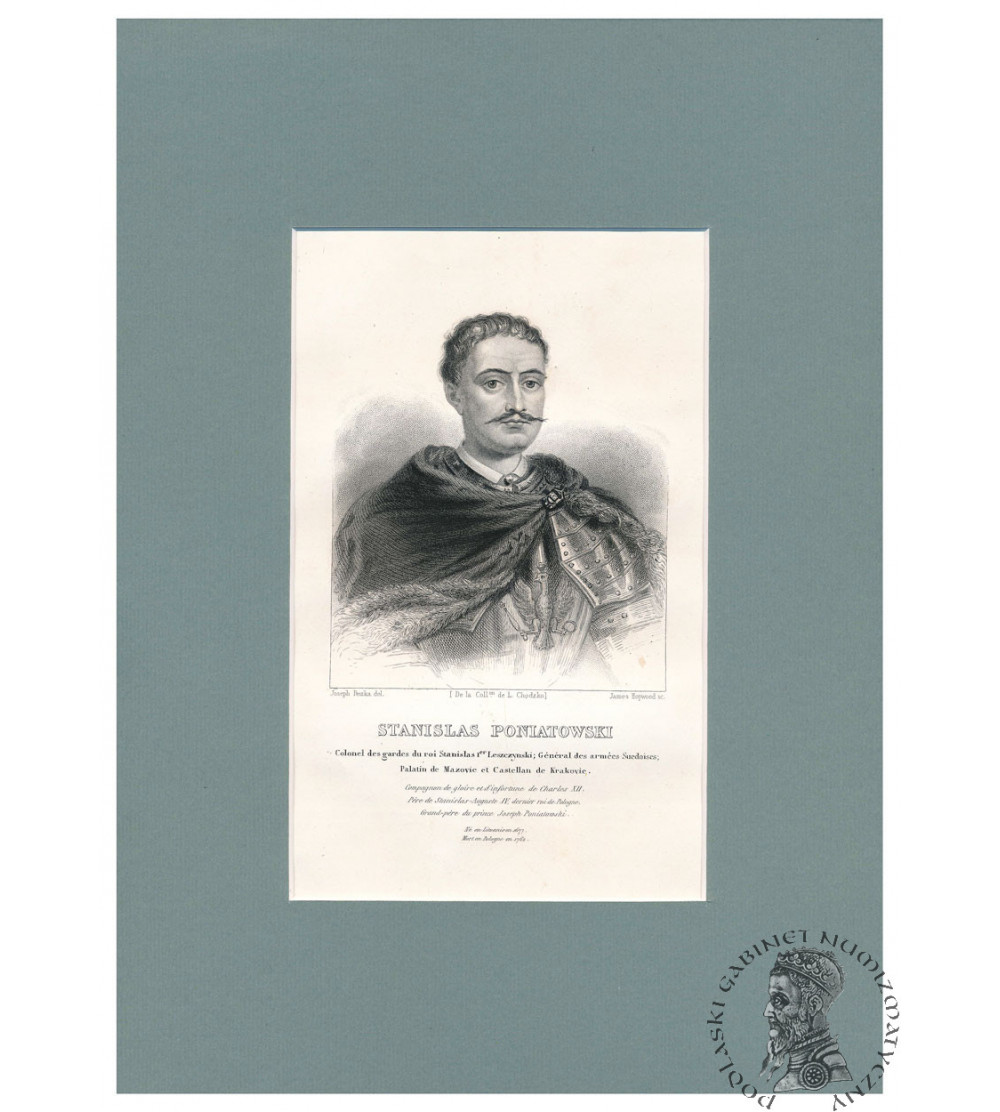




Stanislaw Poniatowski, Colonel of the Guard of King Stanislaw Leszczynski, portrait, 19th century steel engraving, by Michal Stachiewicz, work from Leonard Chodźko's volume - La Pologne historique, litteraire, monumentale et ilustree, Paris 1839-1841, all A4 format (passe-partout), image dimensions 11 cm x 18 cm, very good condition.
Stanislaw August Poniatowski (1732-1798). Elective king of Poland after the death of Augustus III, the last king of the Polish-Lithuanian Commonwealth. He was born on January 17, 1732 in Wolczyn. He was the son of an influential but not very wealthy aristocrat, Stanislaw Poniatowski. Carefully educated, he began his career in the Lithuanian chancellery in 1748. He was a deputy to the Sejm, and from 1755 was a Lithuanian capitalist. He spent several years in St. Petersburg, first as secretary to an English deputy and then as a Saxon deputy. At that time he entered into an affair with the wife of the Russian heir to the throne, the future Tsarina Catherine the Great. With her support, put forward by the Czartoryski family, whom he served, he was elected Polish king on November 25, 1764. Since ascending to the throne, Stanislaw August made efforts to strengthen Polish culture. In 1765 he established the National Theater in Warsaw. In the same year, the Monitor magazine was founded under his patronage, and a Knights School was established in Warsaw to educate future cadets. He formed a permanent Polish diplomatic service. From around 1770 he organized "Thursday dinners." In 1773 he co-founded the Commission of National Education. A patron of the arts and a reformer, he made mostly unsuccessful attempts to modernize the Polish political system and end the prevailing state impotence. On February 24, 1768, the Republic signed a treaty of perpetual friendship with Russia, by virtue of which it became a Russian protectorate. Catherine II, for her part, guaranteed the inviolability of the country's borders and internal system. From 1768 he struggled against the Bar Confederation, which was formed by part of the nobility. In 1772 he failed to stop the first partition of the state, carried out jointly by Prussia, Austria and Russia. Yielding to violence, he joined the Targowitz confederation. His project to change the political system became the basis of the May 3 Constitution adopted in 1791 during the Four-Year Sejm. A year later, Russian troops entered the country, and in 1793 the second partition of Poland took place. Stanislaw Augustus lost real power, and after the outbreak of the Kosciuszko insurrection he became a hostage of the insurgents. On November 25, 1795, at the behest of Tsarina Catherine II, he left Warsaw for Grodno and signed the act of his abdication. He received a lifetime pension from the partitioning states, all the more necessary since he was regarded as one of the most indebted monarchs on the continent. The last king of Poland died in St. Petersburg on February 12, 1798. He is currently buried in the Archcathedral Basilica of St. John the Baptist in Warsaw. Source: ciekawostkihistoryczne.pl
CHODŹKO, Leonard Borejko (1800-1871), La Pologne historique, litteraire et monumentale, (...), 1835-1842. A monumental work by the famous Polish émigré publisher Leonard Chodźko which is a history and geographic-political description of Poland. The work was published in three volumes. The first part is the history of Poland from the earliest times to the reign of Wladyslaw Lokietek. The second volume covers the history of Poland from the reign of Casimir the Great to the death of Stefan Batory, while the last volume covers the history of Poland from the beginning of the reign of Sigismund III Vasa until the events contemporary to the Author and the Readers, i.e. the November Uprising. Each part also contains descriptions of unique and interesting places in Poland, as well as basic information about literature, art and science. In addition, the work contains examples of exceptional monuments in the Polish lands. An important part of the work includes fairy tales, legends and short stories, as well as an essay on dramatic theater in Poland. The work also contains a description of Polish dances, such as the polonaise, mazurka, and krakowiak. The work is very richly illustrated, with numerous intaglios, natural monuments, sacred objects, castles, palaces, cities, portraits of important historical figures from the history of Poland, works of art, notes of songs, etc. This brings the total to 180 engravings (including maps), in a set of three volumes, i.e. 60 engravings for each volume collated with a table at the beginning of the volume.